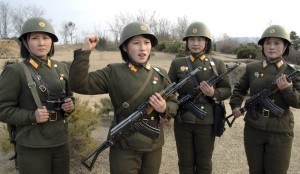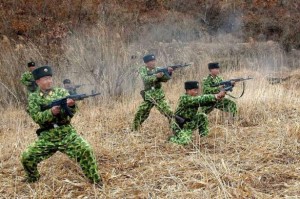Booooring, you say. Cheap copies of crummy comblock stuff, made by starving slave labor. Interesting only because of its sheer quantity. Soon to be the world’s first radioactive parts kits, imported by Century International, if Kim Fat Kid starts something.
Not exactly. Sure, the Norks have copied all the usual stuff from their former Soviet and Chinese sponsors. And even though their GDP is miserably low thanks to classically Communist mismanagement, and its exact amount anyone’s guess, you can indeed build a whole metric crapton of guns if you can spend a third to a half of even a miserable nation’s comic-opera GDP on arms. So that much is true. But the Norks have also developed some interesting weapons of their own. Here’s a video; watch for the oddball pistols:
http://www.youtube.com/embed/ua7hlukgLBY?feature=oembed
(Hat tip, Gun Free Zone, where Miguel was bemused by the Nork conception of gun safety. Heh. Perhaps it’s just that life is cheap in the Orient).
Those Unusual Nork Pistols
We don’t speak Hangook, so we don’t know what these guys are saying, but the metadata say they’re officers of North Korean special operations forces. (Is the fat guy a one-man deception plan? Or is he just illustrative of who gets the calories in a socialist worker’s paradise?) But while the rifles are bog-standard AKMs — Type 68, in Nork nomenclature — the pistols are interesting. They’re the Type 70, a blowback-operated, .32 ACP (7.65 Browning, 7.65X17SR) pistol issued to officers (an older DIA document IDs it as a “Type 64 (New Type)” pistol and notes that it is marked “7.62.” even though it’s .32 ACP). It’s a single action pistol looks a bit like a Browning Model 1910, but it’s hammer-, not striker-fired. There’s also a suppressed version. Norks love them sabotage, espionage, terrorism and so forth, so they produce a lot of suppressed and concealable guns.
Type 64 “7.62” (.32 ACP) pistol. DIA image.
The Norks also make a direct copy of the Browning 1900, the Type 64, also regular or suppressed, in .32. Small Arms Defense Journal erroneously suggests that the suppressor is asymmetric, but the DIA notes it correctly as a standard Maxim type. It looks asymmetric because on the 1900, the barrel is below the recoil spring, unlike most of Browning’s more familiar later designs; that naturally makes the upper bound of the suppressor drop below the sight plane. The DIA also suggests that the suppressed version has a shorter slide, but its own photo doesn’t really seem to bear that out. Instead, it looks like the quiet gun has a longer barrel. DIA notes that the barrel threads are fine, which suggests that the suppressor may normally be left on (as a rule of thumb, finer threads hold a suppressor better, and coarser threads are superior for quickly mounting and dismounting it). If you have a Browning 1900 that is stamped 1964 7.62 on the left side of the frame, you might just have a Type 64.
Why the long-obsolete, retirement age 1900? Small Arms Defense Journal’s Dan Shea speculates that a famous Korean patriot’s assassination of a Japanese overlord with a 1900 adds some cachet to the gun’s reputation in the Land of the Morning Calm.
In addition to suppressed .32 pistols, North Korean SOF, saboteurs and intelligence agents have been known to use Czech Vz61 Skorpion .32 ACP submachine guns, usually with the factory suppressor. The ones we’ve seen have all been Czech made, but there’s no reason the Norks couldn’t copy this subgun/PDW. The Skorpion seems simple, but it’s more sophisticated inside than it looks at a glance. Like the earliest AR prototypes, “safe,” which is marked “0,” is the center of the selector/safety settings. You rotate the safety forward (where it says “20”) for automatic, or rear (“1”) for semi-auto fire. The gun fires from a closed bolt.
The trigger mechanism is a cousin of the AK, or for that matter the M16 or Garand, with the distinctive fore and aft hooks on the hammer. The pistol grip contains a clever cyclic-rate reducing mechanism that comes into play in automatic fire. A hook called the “bolt catch” holds the bolt to the rear while a weighted “actuator” is driven down into the grip. A spring drives a plunger on the actuator back up, where it impacts a lever that trips the bolt catch. This mechanism reduces the cyclic rate some 20% to a still quite high 800 RPM.
Is North Korea interesting yet?
North Korean Type 68, 7.62 x 35. From Modern Firearms (world.guns.ru).
Then, there’s their standard service pistol, for Army officers and not just for spooks. Sure, they once issued the TT-33, but when the rest of the commie world went to the Walther-inspired Makarov or other pocket pistol, the Norks went their own way. First, they modified the TT into the Type 68, which had some features the original lacked — like a safety. It also had a ramp-based locking system (like a Hi-Power or Glock) instead of the cam links of a TT-33 or M1911. The slide serrations differ from Russian or Chinese TTs, also.
Then, they got fascinated with Czech small arms. First, they supposedly bought some CZ-82 or -83 pocket pistols, but then, they adopted the CZ-75. Here’s Kim Chi Breath trying to demonstrate his mastery of one, with bonus target drone shootdown footage.
http://www.youtube.com/embed/Hco8MHiUlak?feature=oembed
You can see the resemblance of the gun Kim handles to the standard 1980s vintage CZ. You can also see the unusual Nork pistol shot scoring system. They don’t actually show where the Beer Leader’s shots hit.
Baek Du San presentation model. Image: KPA Blogger.
Of course, the North Korean “licensees” didn’t pay CZ as much as a the price of a dogmeat casserole. They just copied the Czech pistol, and declared the copyist a great inventor of the North Korean proletariat or something like that. The Korean copy is called the Baek-du-San (“White Head Mountain,” a terrain feature in North Korea held as sacred since ancient times), and closely resembles a mid-1980s CZ, except for the unique grips, the Korean markings — and the so-so workmanship. Supposedly, they chose this because Kim Jong Il was a fan of the CZ, although all information from Norkistan needs to be taken with a grain of salt. One blogger who covers the KPA has a blurb on the Baek-du-san that includes photos of a blinged-out presentation model and a long-barreled target gun. The standard b-d-s is well illustrated in the latest Small Arms Review.
Long guns — and their home-grown MG
What about long guns? For most of their infantry weapons, te Norks are content to copy foreign, mostly Russian, prototypes. AKM, RPK, PK, PKM, DShK, NPV are all in their inventory. (They also produce 5.45 versions of the Kalashnikovs, but it’s unclear how wide the issue of these weapons is). The North Korean SKS (Type 56) , AK-47 (Type 58) and AKM (Type 68) variants differ little from their Soviet forebears; the biggest differences are in markings, except for the Type 68’s absent rate reducer. The AK-74 versions (Type 88 and 88-1) do show some Korean innovation, however. The folding stock rifle is a sidefolder of unique design that resembles an FN-FAL Para stock. There are also unusual helical, high-capacity magazines that have only been observed slunk from the shoulders of Kim’s personal security detail.
There is one weird and wonderful Nork weapon, though, that is entirely home-grown, and quite an oddity at that. That’s the Type 73 light machine gun, a weapon that combines lots of PKM features with a uniquely Nork dual feed system. Like the American SAW, the Type 73 is designed to accept belts and a box magazine interchangeably. (Unlike the SAW, the Type 73’s magazine feed apparently works).
Type 73 LMG. Image: Small Arms Defense Jourmal
The Type 73’s magazine interchanges with nothing; the gun also has a very unusual feature: a grenade launcher. Why? Don’t ask us.
The replacement for the Type 73, the Type 82, is a closer relative of the PKM and dispenses with the magazine feed.
Other relatively rare machine guns still show up in North Korean service. KPA Blogger asked what these oddball MGs were (right) after they appeared in a recent propaganda video. They’re Russian RP-46 (Ruchnoi Pulemyot 1946G, the light or company machine gun of 1946. They were essentially a conversion of the pan-fed DPM to belt feed, and they use the same belts as the SG-43, PKM, and most other 7.62 x 54R mm machine guns, includinh the two North Korean guns (Types 73 and 82).
North Korean minigun-style Gatling gun, about which little is known.
And finally, we have a true oddity, a North Korean minigun in their standard 7.62 x 54R caliber. Little is known about this gun, except that the Norks have tried to export it. The image is from SADJ.
Clandestine and Deniable Weapons
There are also weapons that the Norks use for clandestine service. We’re familiar with these because the South Koreans have captured them — many of them. A few have turned up in Japan as well. Among the most interesting is a copy of the M16 rifle that is, according to SADJ, innocent of any markings whatsoever. It’s unclear whether these “deniable” rifles were made in China (which does make M16 copies) or in North Korea itself.
Adding it up
The North Koreans not only have enough weapons of generally reliable, functional types, they also have a capability to design and engineer their own weapons. Some weapons, like the Type 68 and Type 73, show advantages over, or conceptual departures from, their foreign-designed forerunners. By and large, though, the North Koreans make weapons according to foreign designs, with relatively few modifications. We’ve covered the known exceptions to that rule here.
Then, there’s the day-glow camouflage suits. What? And going back to the first video, there’s all these dogs. If you want proof that the security forces have a tight grip on Norkland, note that those magnificent Shepherds haven’t yet been turned into plates of gaegogi.
References
Johnson, Harold E. Small Arms Identification and Operations Guide — Eurasian Communist Countries. DST1110H-394-76-CHG 1. DIA Task PT-1110-01-01L. Washington: Defense Intelligence Agency, 5 September 1980.
Shea, Dan; Hong, Heebum; Kim, Namho. North Korean Small Arms. Small Arms Defense Journal. 27 Mar 2013. Retrieved from: http://sadefensejournal.com/wp/?p=1785 (this is the best single article on Nork small arms).
Shea, Dan; Hong, Heebum. North Korean Pistol Baek-du-San. Small Arms Review. May-Jun 2013. p. 126. (This is a supplement to the March article in SADJ, with Hong’s photos of the gun which were not available in time for the March story).
US Marine Corps. North Korea Country Handbook. May, 1997. Retrieved from: http://www.fas.org/nuke/guide/dprk/nkor.pdf Note that much of the small arms information in this handbook is inaccurate; trust Shea and Hong instead.
Other websites as linked in the text.

Kevin was a former Special Forces weapons man (MOS 18B, before the 18 series, 11B with Skill Qualification Indicator of S). His focus was on weapons: their history, effects and employment. He started WeaponsMan.com in 2011 and operated it until he passed away in 2017. His work is being preserved here at the request of his family.


